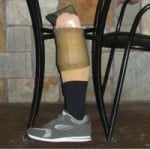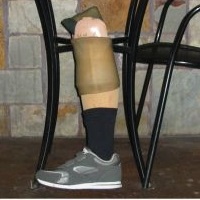 The man sitting in my office had just undergone his third amputation in as many years. First, doctors amputated his right foot after a blister refused to heal and gangrene set in. Then, they cut off the leg just below the knee. Now, he had graduated to “AK” (above the knee). He was losing his leg, inch by inch, to “Big Mac attacks.”
The man sitting in my office had just undergone his third amputation in as many years. First, doctors amputated his right foot after a blister refused to heal and gangrene set in. Then, they cut off the leg just below the knee. Now, he had graduated to “AK” (above the knee). He was losing his leg, inch by inch, to “Big Mac attacks.”
As someone who makes prosthetic limbs for a living, I see a lot of tragedy: children who have lost limbs to cancer, motorcycle accident victims, farmers who’ve lost arms in agricultural machinery. But perhaps the most tragic cases of all are the diabetics who’ve essentially cut off their own legs with a knife and fork.
Diabetes has become an epidemic. More than 25 million Americans have diabetes, and more than 230,000 of them die each year from causes related to the disease. It is now the seventh-leading cause of death in the United States. This November, National Diabetes Month, is the perfect time to do something about it.
Most of my patients have spent a lifetime eating diets rich in animal products loaded with saturated fat and cholesterol, which has left them overweight and suffering from the type-2 or “adult-onset” diabetes that afflicts 90 percent to 95 percent of diabetics. This form of diabetes usually appears after age 40 – think Paula Deen and Aretha Franklin – although it is increasingly being found in younger adults (e.g., Ruben Studdard) and even teens and young children. It is often linked to obesity and inactivity, but even seemingly fit people, such as Tom Hanks, can develop it.
Diabetes can cause heart disease, strokes, blindness, kidney failure and pneumonia. It also leads to nerve damage and poor circulation in the feet and legs, which is where I come in. Limited blood flow makes it hard for sores and infections to heal and can ultimately lead to amputation of a toe, foot or leg. More than 65,000 people have diabetes-related leg and foot amputations each year. Sixty percent of all lower-limb amputations not resulting from trauma occur in people with diabetes. Most diabetic amputees don’t live long – the majority of my patients are dead within nine years of their first amputation.
So how can you stay on your feet and out of my office? Easy: Eat a low-fat, high-fiber, plant-based diet. Recent studies indicate that fat impairs insulin’s ability to function and that blood-sugar levels are under better control when people eat diets that are high in fiber and low in fat.
A study led by Dr. Neal Barnard, author of Dr. Neal Barnard’s Program for Reversing Diabetes: The Scientifically Proven System for Reversing Diabetes without Drugs, showed that 43 percent of diabetics on a low-fat vegan diet were able to cut back on their medications, compared to only 26 percent of those who followed the diet recommended by the American Diabetes Association. A Harvard School of Public Health study suggests that eating red meat and processed meats can increase a person’s risk for type-2 diabetes by as much as 50 percent.
Barnard, president of the vegan organization Physicians Committee for Responsible Medicine, encourages diabetics to eat low-fat plant-based foods with a low glycemic index, such as beans, peas, lentils, sweet potatoes, spinach, kale, broccoli, cauliflower, tomatoes, carrots, brown rice, barley, quinoa, whole-grain pasta, bananas, apples, peaches, berries and citrus fruits. He also advises people to avoid added vegetable oils and other high-fat foods as well as refined sugar and flour.
Dietary changes alone can help cut back on the amount of insulin needed – or eliminate it altogether in some cases – and minimize complications. I’ve seen the “complications” of diabetes firsthand, and I want to keep my legs – which is why I’m a vegetarian.
Author William M. Mullins is a certified prosthetist in Knoxville, Tenn.
PETA is a participant in the Amazon Services LLC Associates Program, an affiliate advertising program designed to provide a means for sites to earn advertising fees by advertising and linking to Amazon.com.





